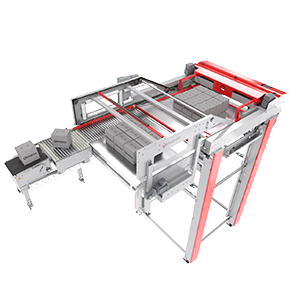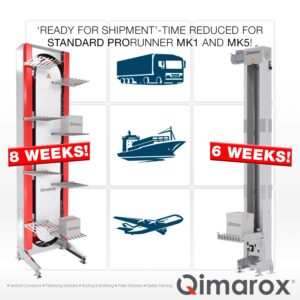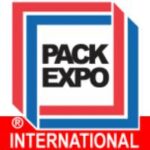Online wine retailer Laithwaites has installed a fully automated palletising solution in Gloucester, UK. Unique is the speed with which the two Qimarox palletizers – installed and integrated by system integrator CKF – can switch between different stacking patterns with different box sizes. Thanks to Qimarox’s new multi-palletiser software, Laithwaites can now palletise 2000 boxes per hour.
For over fifty years, Laithwaites has selected the best wines from around the world for customers in England. To this end, Tony Laithwaites and his team draw on their personal network of more than 450 passionate winemakers. Laithwaites’ wines are popular, as evidenced by the increase in online sales. Consumers can visit the website www.directwines.co.uk, where they can choose from a wide range and order per bottle. Laithwaites packs the ordered wines in a box and sends them to the customer.

Because the existing operation in Gloucester could no longer handle the growing number of online orders, Laithwaites contacted system integrator CKF at the end of 2019. In particular, the wine importer wanted to put an end to manual palletising of the heavy boxes of wine. The boxes can weigh up to 25 kilograms per box. In close collaboration with Qimarox, CKF has designed and implemented a fully automated palletising system. At its heart are two Qimarox Highrunner HR7 palletizers , which together can palletise no less than 2,000 boxes per hour.
Quick switching of stacking pattern
The big challenge was the speed and complexity of the e-commerce operation. Because not every customer orders the same amount, Laithwaites packs the wine in boxes of two different sizes. The company then divides these boxes into eight different transport flows based on the chosen delivery time and destination. Before the boxes can be transported, they must be stacked on pallets.
A sophisticated conveyor system has been designed for this, consisting of ten buffer lanes. For each flow, the boxes are collected in the correct order on one of these buffer lanes. As soon as a pallet load is complete, it is called off in one go and delivered to one of Qimarox’s two Highrunners HR7. As it is only shortly beforehand clear which boxes have to be stacked in which format, these palletizers must be able to switch stacking patterns at lightning speed.
Qimarox’s unique multi-palletiser software offers a solution. This software calculates the optimal stacking pattern for boxes of different shapes and sizes. That stacking pattern is then converted into instructions for the Qimarox palletizers. Thanks to this software, they can switch very quickly. While the last layer of boxes is still being placed on the pallet, the first layer for the next pallet is already being formed in accordance with the new stacking pattern.
Fast, efficient and reliable
The decision to choose Qimarox’s Highrunners HR7 was not immediately obvious. Initially, there were doubts as to whether the machines could withstand the heavy loads. This can be to 200 kilograms per pallet layer. Because it is a delicate product with a price per box that can run up to several hundred euros, Laithwaites cannot afford any product damage. An extensive test with a test pallet in the Qimarox test centre in Harderwijk has put an end to all doubts.
What sets the Highrunner apart from many other solutions such as palletising robots in this respect is that the boxes are carried from below throughout the palletising cycle. The chance of a box collapsing under the weight of its contents is therefore virtually zero. Because the palletizers can continue to run at maximum speed without the risk of product damage, no more than two Highrunners are required to process the large flow of boxes – quickly and efficiently, without any loss of lead time.
The total solution including buffer lanes and palletizers was installed and commissioned in phases in 2020. A significant increase in productivity is the result of this investment. Moreover, because the solution is built on a mezzanine, extra space is freed up on the floor. This not only provides room for further growth, but also increases safety for employees.
Automatic palletising in e-commerce
This project underlines the good cooperation between system integrator CKF and Qimarox, designer and manufacturer of material handling components. CKF realises automation solutions in food and logistics and has been using Qimarox vertical transport systems for years. With the unique palletizers from Qimarox, CKF now has an even broader portfolio of palletising solutions. The fact that CKF is a certified Qimarox partner offers end customers the guarantee that the system integrator has all the knowledge required to implement and maintain these solutions.
“The main challenge on this system was the complexity of the logistics of the customer’s case handling. Working closely with Qimarox, we developed a bespoke design that met our customer’s unique needs. Utilizing Qimarox’s palletizer meant the system was high-speed whilst also giving the option to pre-buffer complete pallets for varying couriers. The handling offered by the Qimarox palletizer was also vital due to the fragility of the project. This layer palletizer also provided a smaller footprint on the project.”
“The palletising modules from Qimarox mean we are able to offer our customers a wider range of solutions, it’s also very beneficial that Qimarox supplies standard software for multipalletising. Partnering with Qimarox gives us the flexibility to offer our customers layer palletizers in addition to our robotic palletising offering which means we can provide and install a palletising system for practically any project.” – CKF
Focus brings innovation
A key success factor is Qimarox’s focus on the development and production of advanced material handling components. This focus has not only led to efficient, fast and reliable solutions with a low total cost of ownership, but also to important innovations. The new multi-palletiser software is just one of them. This means that automatic palletising is now also within reach of companies in e-commerce and other sectors, which are confronted with rapid changes in stacking patterns and a great diversity in packaging forms.
















